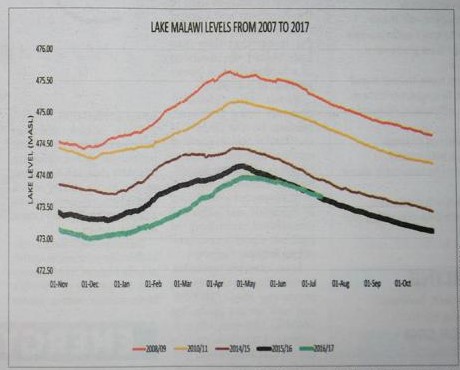
Power generation woes have moved from bad to worse with a loss of 20 megawatts (MW) within a week, a situation that has prompted a drastic load shedding programme that will see some areas having over 24 hours of no power.
Electricity Generation Company (Egenco), which sells its power to Electricity Supply Corporation of Malawi (Escom) for supply to consumers, yesterday described the downward spiral of power generation from 180MW to 160MW as “so alarming”.
To paint a picture of the loss, the lost 20MW is enough to light the entire Northern Region and a larger part of the Central Region, according to an energy expert.
With no rains in sight in the Northern and Central regions, home to most of the rivers that flow into Lake Malawi, the likelihood of a further drop in power generation is a reality.
From the 160MW currently being generated, between 60 and 70 MW is reserved for critical centres of national interest, including hospitals and water boards, with the remaining 100MW or less expected to be shared by domestic and industrial consumers, according to Egenco chief executive officer William Liabunya.
In an interview yesterday, he said: “Last week, we were producing about 180MW and now we are producing 160MW. However, when it comes to load shedding, it is Escom that decides who gets power at what time.”
This week Escom announced an extended nationwide power rationing schedule that will see some areas going between a minimum of nine hours and a maximum of 25 hours without power.
Liabunya said water levels in Shire River, the sole outlet of Lake Malawi and home to over 90 percent of Escom’s hydro-electric power plants that produce 350MW, keep dropping, resulting in reduced power production.
In a statement published in The Nation yesterday, Escom said it is currently accessing between 145MW and 150MW against the average demand of 300MW.
“The country is experiencing frequent load shedding of electricity due to shortage of electricity available for distribution to customers,” reads the press release.
Escom public relations manager Kitty Chingota said in a telephone interview that at the moment the critical areas that are not switched off are all central hospitals, all water boards and Mpingwe Hill where most radio and telephone antennas are mounted.
“The Southern Region gets about 55 percent of the load while Central Region gets about 30 percent. The remainder goes to the Northern Region. This is the distribution breakdown,” she said.
Chingota explained that domestic customers have been grouped into three to share the 24 hours of the day.
She said: “In essence, the customers will have eight hours of supply and 16 hours of load shedding everyday over a 24 hours period.”
She said there was need to change times of supply; hence, due to that customers may experience 24 hours blackout.
But the country should not expect great improvement in the power generation soon as Liabunya said efforts to buy generators would be ‘just’ a quick-fix solution not an alternative.
He said the country should face the reality that it neglected investment in the energy sector for years.
Said Liabunya: “It is true that diesel generation is more expensive than hydro and that is why diesel is unpopular. We have just evaluated the tenders and, therefore, have known what the potential suppliers would be charging for their services.”
Currently, Escom is selling electricity to consumers at $0.08 per kilowatt hour.
However, Escom and Egenco are yet to reach an agreement on how much they have to sell the electricity to each other as the power-sell agreement between the two companies is yet to be signed.
Former minister of Energy and Mining Grain Malunga told The Nation that generators were expensive and that they are likely to push the tariffs up if the whole project was to be sustainable.
He said: “At Kayerekera [Uranium Mine in Karonga] we were using 400 litres of diesel to produce eight kilowatts. The company was spending about K3 million a day.”
Liabunya admitted that diesel generation was expensive.
But he said: “We are in a very desperate situation. We have little choice but to come up with a solution in this alarming situation.”
Ironically, it is Egenco—a power producer—discussing with other power producers for energy that would be sold to Escom.
But Liabunya said Egenco is not assuming the role of an electricity buyer, but rather was discussing with other producers as a partnership.
He said: “These hired generators will supplement the Egenco generation and Egenco will then sell that power to Escom.”
Egenco plans to add the 6MW, 10MW and 20MW for Mzuzu, Lilongwe and Blantyre respectively by November, December 2017; and February 2018 and March 2018 through generators.
Escom botched up the generator deal some few months ago when it went against own recommendation to award the supply of generators to a company called Aggreko. The deal was cancelled and Egenco had to start all over again.
The President last week ‘gate-crashed’ into Escom and Egenco meeting and later hinted that power outages may only improve in a year’s time.
